
The San Antonio Spurs are an American professional basketball team based in San Antonio. The Spurs compete in the National Basketball Association (NBA) as a member of the Southwest Division of the Western Conference. The team plays its home games at Frost Bank Center in San Antonio.

The San Diego Conquistadors, were an American Basketball Association (ABA) team based in San Diego. The "Q's", as they were popularly known, played from 1972 to 1975. As the Sails, they played an incomplete season only, beginning the 1975–1976 season but folding after only 11 games with 3 wins and 8 losses.

The Dallas Chaparrals were a charter member of the American Basketball Association (ABA). The team moved to San Antonio, Texas, for the 1973–74 season and were renamed the San Antonio Spurs. The Spurs joined the National Basketball Association (NBA) for the 1976–77 NBA season as a result of being one of four chosen ABA teams to be absorbed by the elder league following the completion of the ABA–NBA merger.
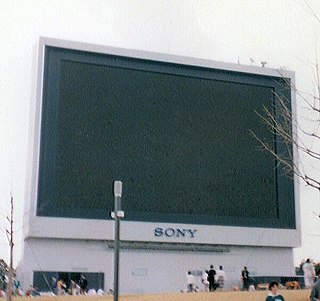
A jumbotron, sometimes referred to as jumbovision, is a video display using large-screen television technology. The original technology was developed in the early 1980s by Mitsubishi Electric and Sony, which coined JumboTron as a brand name in 1985. Mitsubishi Electric sold their version of the technology as Diamond Vision. It is typically used in sports stadiums and concert venues to show close up shots of an event or even other sporting events occurring simultaneously, as well as outdoor public places.

Oakland Arena is an indoor arena located in Oakland, California, United States. From its opening in 1966 until 1996, it was known as the Oakland–Alameda County Coliseum Arena. After a major renovation completed in 1997, the arena was renamed The Arena in Oakland until 2005 and Oracle Arena from 2006 to 2019. It is often referred to as the Oakland Coliseum Arena as it is part of the Oakland–Alameda County Coliseum Complex with the adjacent Oakland Coliseum. Oakland Arena seats 19,596 fans for basketball.

Frost Bank Center is a multi-purpose indoor arena on the east side of San Antonio, Texas, United States. It is the home of the San Antonio Spurs of the National Basketball Association (NBA).
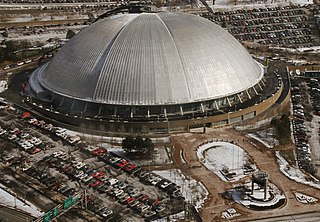
The Civic Arena, formerly the Civic Auditorium and later Mellon Arena, was an arena located in Downtown Pittsburgh, Pennsylvania. The Civic Arena primarily served as the home to the Pittsburgh Penguins, the city's National Hockey League (NHL) franchise, from 1967 to 2010.

The Alamodome is a 64,000-seat domed indoor multi-purpose stadium in San Antonio, Texas. It is located on the southeastern fringe of downtown San Antonio. The facility opened on May 15, 1993, having been constructed at a cost of $186 million.
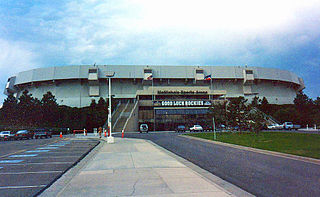
McNichols Sports Arena was an indoor arena located in Denver, Colorado, United States. Located adjacent to Mile High Stadium and completed in 1975, at a cost of $16 million, it seated 16,061 for hockey games and 17,171 for basketball games.

Market Square Arena was an indoor arena in Indianapolis. Completed in 1974, at a cost of $23 million, it seated 16,530 for basketball and 15,993 for ice hockey. Seating capacity for concerts and other events was adjusted by the use of large curtains which sealed off the upper rows. The arena closed down in 1999 and was demolished two years later.

Omni Coliseum was an indoor arena in Atlanta, Georgia, United States. Completed in 1972, the arena seated 16,378 for basketball and 15,278 for hockey. It was part of the Omni Complex, now known as the CNN Center.
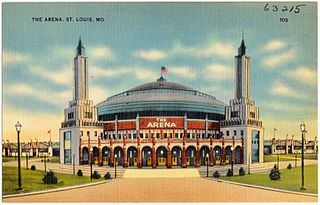
St. Louis Arena was an indoor arena in St. Louis, Missouri. The country's second-largest indoor entertainment venue when it opened in 1929, it was home to the St. Louis Blues and other sports franchises. The Arena sat across I-64 from Forest Park's Aviation Field.
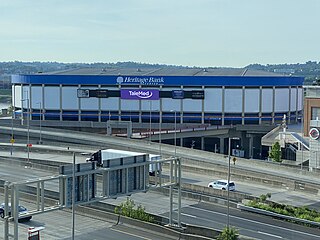
Heritage Bank Center is an indoor arena located in downtown Cincinnati, next to the Great American Ball Park. It was completed in September 1975 and named Riverfront Coliseum because of its placement next to Riverfront Stadium. In 1997, the facility became known as The Crown, and in 1999, it changed its name again to Firstar Center after Firstar Bank assumed naming rights. In 2002, following Firstar's merger with U.S. Bank, the arena took on the name U.S. Bank Arena and kept that name until 2019.

The Houston Mavericks were a charter member of the American Basketball Association (ABA). They played in the upstart league's first two seasons, from 1967 to 1969. Their home arena was the Sam Houston Coliseum. In 1947–48, there was an unrelated Mavericks franchise based in Houston as part of the Professional Basketball League of America.

Freedom Hall is a multi-purpose arena in Louisville, Kentucky, on the grounds of the Kentucky Exposition Center, which is owned by the Commonwealth of Kentucky. It is best known for its use as a basketball arena, previously serving as the home of the University of Louisville Cardinals and, since November 2020, as the home of the Bellarmine University Knights. It has hosted Kiss, Grateful Dead, Chicago, AC/DC, WWE events, Mötley Crüe, Elvis Presley, The Doors, Janis Joplin, Creed, Led Zeppelin, Van Halen, Coldplay and many more. As well as the Louisville Cardinals men's basketball team from 1956 to 2010, the arena's tenants included the Kentucky Colonels of the American Basketball Association from 1970 until the ABA-NBA merger in June 1976, and the Louisville Cardinals women's team from its inception in 1975 to 2010. The Kentucky Stickhorses of the North American Lacrosse League used Freedom Hall from 2011 until the team folded in 2013. From 2015 to 2019 it has hosted the VEX Robotics Competition World Championship Finals yearly in mid-April.

Pechanga Arena is an indoor arena in San Diego, California. The arena opened in 1966 and hosts a capacity of 16,100.

Sam Houston Coliseum was an indoor arena located in Houston, Texas.
Spurs Sports & Entertainment L.L.C. (SS&E) is an American sports & entertainment organization, based in San Antonio, Texas. The company owns and operates several sporting franchises including the National Basketball Association (NBA) San Antonio Spurs, NBA G League Austin Spurs, and the USL Championship club San Antonio FC. SS&E also operates the Bexar County-owned multi-purpose facility, the Frost Bank Center.

The Salt Palace was an indoor arena located in Salt Lake City, Utah. Built on land that was once the "Little Tokyo" area of the city, construction was pushed by Salt Lake's bid committee for the 1972 Winter Olympics, which included Gen. Maxwell E. Rich, president of the Greater Salt Lake Chamber of Commerce, Gov. Cal Rampton, and Salt Lake Tribune publisher John W. Gallivan.

















